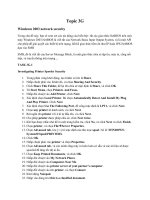29 switch security
Bạn đang xem bản rút gọn của tài liệu. Xem và tải ngay bản đầy đủ của tài liệu tại đây (541.7 KB, 22 trang )
Switch Security
BSCI v3.0—2-1
Types of Attacks
• CAM table overflow
• VLAN hopping
• Spanning Tree manipulation
• MAC address spoofing
• DHCP attacks
CAM Table Overflow Attack
3/25 MAC X
3/25 MAC Y
3/25 MAC Z
3/25
BD
VLAN 10
VLAN 10
XYZ
Attacker sees traffic
to servers B and D
A
C
B
D
Port Security
MAC A
MAC D
MAC E
MAC F
MAC A
Attacker
Attacker
VLAN Hopping
VLAN
10
802.1Q
Trunk
Server
VLAN
20
Attacker sees
traffic to servers
Server
Mitigating VLAN Hopping
switch(config-if)# switchport mode access
Configure port as an access port
Spanning Tree Manipulation
Root Bridge
F
F
F
F
F
B
B
F
F
F
F
F
Root Bridge
Implementing BPDUGuard to Mitigate
Spanning Tree Manipulation
Switch(config)#spanning-tree portfast bpduguard
or
Switch(config-if)#spanning-tree bpduguard enable
The BPDU – guard feature shuts down ports when ports receive BPDU.
Auto recovery from err-disable state
• If the BPDU – guard feature has shutdown a port, the port can be
restored to an operational state using the error-disable recovery
procedure.
• Enable recovery cause is BPDU – guard :
Switch(config)#errdisable recovery cause bpduguard
• Set a global recovery timeout by using the command:
Switch(config)#errdisable recovery interval seconds
DHCP Attacks
DHCP Server
DHCP
requests with
spoofed MAC
addresses
Untrusted
Attacker attempting
to set up rogue
DHCP server
Attacker attempting to
starve DHCP server
Mitigating DHCP Attacks
Here are two ways to mitigate DHCP spoofing and starvation
attacks:
• Port security
• DHCP snooping
DHCP Snooping
• DHCP snooping allows the
configuration of ports as trusted or
untrusted.
Rouge DHCP
Attacker
• Untrusted ports cannot process
DHCP replies.
• Configure DHCP snooping on
uplinks to a DHCP server.
• Do not configure DHCP snooping on
client ports.
Legitimate
DHCP Server
Client
IEEE 802.1x
• Standard set by the IEEE 802.1 working group
• A framework designed to address and provide port-based access
control using authentication
• Layer 2 protocol for transporting authentication messages between
supplicant (user/PC) and authenticator (switch or access point)
• Actual enforcement is via MAC-based filtering and port-state
monitoring
Concepts of 802.1x in Action
Identity-Based
Authentication
Authorized User
Valid Credentials
√
Corporate
Network
X
No Access
Invalid/No Credentials
Unauthorized External
Wireless User
Corporate
Resources
802.1x and Port Security
A = Attacker
Hub
I don’t know A,
I know B.
Port unauthorized
Port Security
and
Identity
B = Legitimate User
Cisco Secure
ACS/RADIUS
Implementing Switch Port Analyzer
SPAN
BSCI v3.0—2-16
Switch Port Analyzer
• The Switch Port Analyzer (SPAN) feature is used to mirror traffic from
one source switch port or VLAN to a destination port.
• It allows a monitoring device, such as a network analyzer or “sniffer”, to
be attached to the destination port for capturing traffic.
• SPAN is available in two different forms:
SPAN: Both the SPAN source and destination are located on the
same switch.
Remote SPAN (RSPAN): The SPAN source and destination are
located on different switches. Mirrored traffic is copied over a special
– purpose VLAN across trunks between switches from the source
to the destination.
SPAN
Both the SPAN source and destination are located on the same
switch.
SPAN Configuration
Define the source of the SPAN session data:
Switch(config)# monitor session-id source {vlan vlanlist | interface interface-number} [tx | rx | both]
• session-id: Uniquely identify the SPAN session.
• source interface interface-number: Specify the interface
which traffic incoming or outgoing traffic will be monitored.
• source vlan vlan-list: Specify the VLANs which traffic transit
through will be monitored.
• tx | rx | both: Traffic can be selected for mirroring based on the
direction it is traveling the SPAN source (tx: transmitted from the
source, rx: received from the source, both: traffic in both directions).
SPAN Configuration (Cont.)
Identify the SPAN destination:
Switch(config)# monitor session-id destination interface
interface-number [encapsulation replicate][ingress {vlan
vlan-id | dot1q vlan vlan-id | isl}]
• session-id: Uniquely identify the SPAN session.
• destination interface interface-number: Identify the
destination interface used by the session.
• encapsulation replicate: Capture any VLAN tagging information
of the Layer 2 Protocol packets.
• ingress vlan vlan-id: Allows sending traffic into the destination
port. Sending traffic will be sent untagged to VLAN vlan-id.
• ingress {dot1q vlan vlan-id | isl}: Allows sending traffic into
the destination port. Sending traffic will be sent with tag dot1q or ISL.
With dot1q tag, native VLAN is specified.
SPAN Configuration (Cont.)
• Example:
SW(config)# monitor session 1 source interface g1/0/1 both
SW(config)# monitor session 1 destination interface g1/0/48
• Monitoring traffic going to and coming from a device connected to the
interface g1/0/1 and the network analyzer is connected to the interface
g1/0/48.









